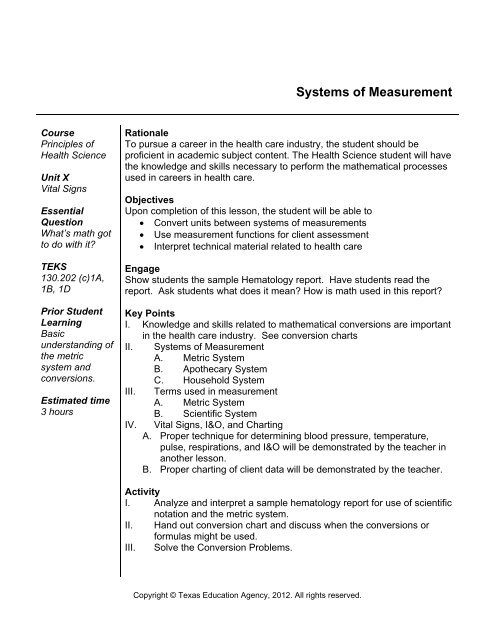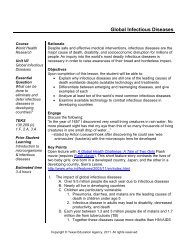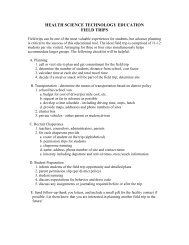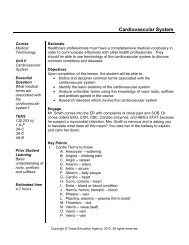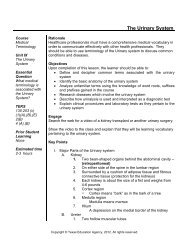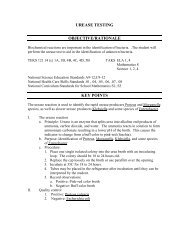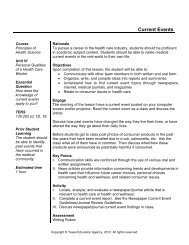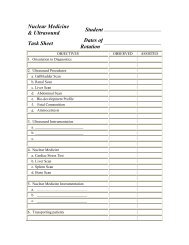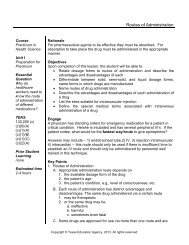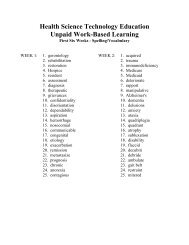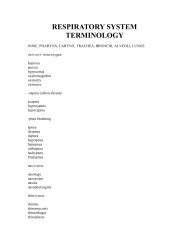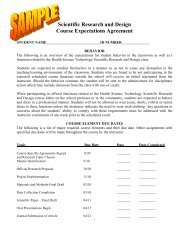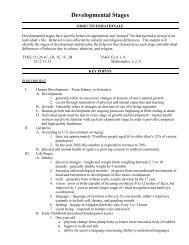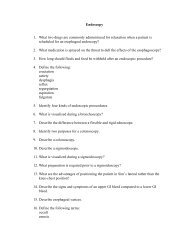Systems of Measurement - Texas Health Science!
Systems of Measurement - Texas Health Science!
Systems of Measurement - Texas Health Science!
You also want an ePaper? Increase the reach of your titles
YUMPU automatically turns print PDFs into web optimized ePapers that Google loves.
<strong>Systems</strong> <strong>of</strong> <strong>Measurement</strong><br />
Course<br />
Principles <strong>of</strong><br />
<strong>Health</strong> <strong>Science</strong><br />
Unit X<br />
Vital Signs<br />
Essential<br />
Question<br />
What’s math got<br />
to do with it<br />
TEKS<br />
130.202 (c)1A,<br />
1B, 1D<br />
Prior Student<br />
Learning<br />
Basic<br />
understanding <strong>of</strong><br />
the metric<br />
system and<br />
conversions.<br />
Estimated time<br />
3 hours<br />
Rationale<br />
To pursue a career in the health care industry, the student should be<br />
pr<strong>of</strong>icient in academic subject content. The <strong>Health</strong> <strong>Science</strong> student will have<br />
the knowledge and skills necessary to perform the mathematical processes<br />
used in careers in health care.<br />
Objectives<br />
Upon completion <strong>of</strong> this lesson, the student will be able to<br />
Convert units between systems <strong>of</strong> measurements<br />
Use measurement functions for client assessment<br />
Interpret technical material related to health care<br />
Engage<br />
Show students the sample Hematology report. Have students read the<br />
report. Ask students what does it mean How is math used in this report<br />
Key Points<br />
I. Knowledge and skills related to mathematical conversions are important<br />
in the health care industry. See conversion charts<br />
II. <strong>Systems</strong> <strong>of</strong> <strong>Measurement</strong><br />
A. Metric System<br />
B. Apothecary System<br />
C. Household System<br />
III. Terms used in measurement<br />
A. Metric System<br />
B. Scientific System<br />
IV. Vital Signs, I&O, and Charting<br />
A. Proper technique for determining blood pressure, temperature,<br />
pulse, respirations, and I&O will be demonstrated by the teacher in<br />
another lesson.<br />
B. Proper charting <strong>of</strong> client data will be demonstrated by the teacher.<br />
Activity<br />
I. Analyze and interpret a sample hematology report for use <strong>of</strong> scientific<br />
notation and the metric system.<br />
II. Hand out conversion chart and discuss when the conversions or<br />
formulas might be used.<br />
III. Solve the Conversion Problems.<br />
Copyright © <strong>Texas</strong> Education Agency, 2012. All rights reserved.
Assessment<br />
Successful completion <strong>of</strong> Conversion Problems<br />
Materials<br />
Sample Hematology Report<br />
Access to one or more <strong>of</strong> the following resources is recommended:<br />
Simmers, Louise, Diversified <strong>Health</strong> Occupations, 7 th edition, Delmar,<br />
2009, ISBN 9781418030216<br />
Kennamer, Michael, Mathematics for <strong>Health</strong> Care Pr<strong>of</strong>essionals, Delmar,<br />
2005, ISBN 9781401858032<br />
Pickar, Gloria D., Dosage Calculations, Delmar, 2008, ISBN<br />
9781418080471<br />
Any Medical Mathematics book is helpful.<br />
www.hosa.org/natorg/sectb/cat-i/mm.pdf ( HOSA Medical Math Contest with<br />
Conversion charts)<br />
Accommodations for Learning Differences<br />
For reinforcement, the student will identify the difference between scientific<br />
notation and the metric system data.<br />
For enrichment, the student will research rationale for using the metric<br />
system in health care and why it was not adopted as the universal system in<br />
the United States.<br />
National and State Education Standards<br />
National <strong>Health</strong> <strong>Science</strong> Cluster Standards<br />
HLC1O.01 Technical Skills<br />
<strong>Health</strong> Care Workers will apply technical skills required for all career<br />
specialties. They will demonstrate skills and knowledge as appropriate.<br />
TEKS<br />
130.202 (c)(1)(A) convert units between systems <strong>of</strong> measurement;<br />
130.202 (c)(1)(B) apply data from tables, charts, and graphs to provide<br />
solutions to health-related problems; and<br />
130.202 (c)(1)(D) organize, compile, and write ideas into reports and<br />
summaries.<br />
Copyright © <strong>Texas</strong> Education Agency, 2012. All rights reserved.
<strong>Texas</strong> College and Career Readiness Standards<br />
Mathematics<br />
IV. A. 1. Select and use the appropriate type <strong>of</strong> unit for the attribute being<br />
measured.<br />
IV. B. 1. Convert from 1 measuring system to another<br />
IV. B. 2. Convert within a single measurement system.<br />
Copyright © <strong>Texas</strong> Education Agency, 2012. All rights reserved.
Mathematics Conversion Chart<br />
Length<br />
1 meter = 100 centimeters<br />
1 meter = 1000 millimeters<br />
10 millimeters = 1 centimeter<br />
1 inch = 2.5 centimeters<br />
Volume for Fluids<br />
1 liter = 1000 milliliters<br />
1 milliliter = 1 cubic centimeter<br />
10 centiliters = 1 deciliter<br />
10 deciliters = 1 liter<br />
1 teaspoon = 5 milliliters<br />
1 tablespoon = 15 milliliters<br />
1 ounce = 30 milliliters<br />
1 pint = 500 milliliters<br />
1 quart = 1000 milliliters<br />
Weight Conversions<br />
1 gram = 1000 milligrams<br />
1 kilogram = 1000 grams<br />
1 kilogram = 2.2 pounds<br />
1 pound = 16 ounces<br />
Temperature Conversions<br />
Celsius to Fahrenheit ( 0 C x 1.8) + 32 = 0 F<br />
Fahrenheit to Celsius ( 0 F – 32) ÷ 1.8 = 0 C<br />
Terms and abbreviations<br />
Gram (g) measures mass or weight<br />
Liter (l) measures volume or liquid<br />
Meter (m) measures length or distance<br />
Kilo (k) = thousands<br />
Deci (d) = tenths<br />
Centi (c) = hundredths<br />
Milli (m) = thousandths<br />
Copyright © <strong>Texas</strong> Education Agency, 2012. All rights reserved.
DOSE AND DOSAGES<br />
YOUNG'S RULE:<br />
Child's Dose = (Child's Age (in years)/Child's Age in Years + 12) x Adult Dose<br />
FRIED'S RULE:<br />
Infant's Dose = (Age (in months) /150 pounds) x Adult Dose<br />
CLARK'S RULE:<br />
Child's Dose = (Weight <strong>of</strong> Child (in pounds) / 150 pounds) x Adult Dose<br />
Child's Dose = (Weight <strong>of</strong> Child (in kilograms) / 68 kilograms) x Adult Dose<br />
SOLUTIONS<br />
Ratio Strength <strong>of</strong> Solutions = amount <strong>of</strong> drug / amount <strong>of</strong> solution<br />
Percent <strong>of</strong> Strength by Volume = (volume <strong>of</strong> solute/volume <strong>of</strong> solution)x100<br />
Percent Strength by Weight (Mass) = (mass <strong>of</strong> solute/volume <strong>of</strong> solution)x100<br />
Amount <strong>of</strong> Solute /Amount <strong>of</strong> First Solution = Amount <strong>of</strong> Solute / Amount <strong>of</strong> Second Solution<br />
BODY SURFACE AREA<br />
Used to determine drug dosage in infants and children and also used to determine the loss <strong>of</strong><br />
body fluid in ml/hour in burn patients.<br />
Formula: BSA (m2)=0.20247 x height (m) 0.725 x weight (kg)0.425<br />
Web site to automatically calculate BSA:<br />
http://www-users.med.cornell.edu/~spon/picu/calc/bsacalc.htm<br />
http://www.halls.md/body-surface-area/bsa.htm<br />
IV DROP RATE CALCULATION<br />
CC’S/hour x Drop Factor <strong>of</strong> the tubing divided by 60 (minutes) = drops/minute<br />
Copyright © <strong>Texas</strong> Education Agency, 2012. All rights reserved.
Calculating the Amount <strong>of</strong> Skin Burned<br />
Overall, burn severity is a measurement <strong>of</strong> the depth <strong>of</strong> burning and the size <strong>of</strong> the burn.<br />
Measuring the size <strong>of</strong> a burn is difficult because every person is different in size, shape and<br />
weight. It's impossible to simply choose what universal size <strong>of</strong> burn is significant. A square foot<br />
<strong>of</strong> burned surface area is much worse to a person who weighs 130 pounds than it is to someone<br />
who weighs 200 pounds.<br />
To account for inequities in size and shape, burned surface area is calculated as a percentage<br />
<strong>of</strong> total body area. Of course, we don't actually know how many square inches <strong>of</strong> skin covers<br />
any single person, but we do know about how much <strong>of</strong> our skin it takes to cover our arms and<br />
legs, for example.<br />
The Rule <strong>of</strong> Nines<br />
To approximate the percentage <strong>of</strong> burned surface area, the body has been divided into eleven<br />
sections:<br />
<br />
<br />
<br />
<br />
<br />
<br />
<br />
<br />
<br />
<br />
<br />
Head<br />
Right arm<br />
Left arm<br />
Chest<br />
Abdomen<br />
Upper back<br />
Lower back<br />
Right thigh<br />
Left thigh<br />
Right leg (below the knee)<br />
Left leg (below the knee)<br />
Each <strong>of</strong> these sections takes about nine percent <strong>of</strong> the body's skin to cover it.<br />
Added all together, these sections account for 99 percent. The genitals make up the last one<br />
percent.<br />
To apply the rule <strong>of</strong> nines, add up all the areas <strong>of</strong> the body that are burned deep enough to<br />
cause blisters or worse (2 nd or 3 rd degree burns). For example, the entire left arm and the chest<br />
covered in blisters would be 18 percent. Partial areas are approximated. For example, the face<br />
is only the front half <strong>of</strong> the head and would be considered 4.5 percent.<br />
Since kids are shaped so much different than adults, there are adjustments made to the rule <strong>of</strong><br />
nines, which <strong>of</strong> course ruins the point <strong>of</strong> making this tool the rule <strong>of</strong> nines. So many variations<br />
exist that it would be fruitless to go into them here.<br />
The most important thing to remember about the rule <strong>of</strong> nines is that it is intended to be used in<br />
the field to quickly determine if victims need to go to a specialty burn center. Once the victim is<br />
in a burn center, more advanced techniques will be used to determine the exact burned surface<br />
area. (taken from firstaid.about.com)<br />
Copyright © <strong>Texas</strong> Education Agency, 2012. All rights reserved.
Conversion Problems<br />
1. Lidocaine is available in an ampule with 100 mg in 5 ml <strong>of</strong> solution. How many ml do you<br />
give to administer 65 mg<br />
2. The temperature in the classroom is 86 oF. What is this in celsius<br />
3. You fill a storage cabinet with 12 bottles <strong>of</strong> dextrose. Each bottle contains 15 ½ ounces.<br />
How many ounces <strong>of</strong> this solution are in the storage cabinet<br />
4. The physician will need a needle 7.5 cm long to take a bone marrow sample. This is<br />
equal to how many inches<br />
5. The stomach produces about 8 cups <strong>of</strong> gastric acid each day. How many liters is this<br />
6. The temperature today is –10 °F. What is the temperature in Celsius<br />
7. The doctor gives you a prescription for a cough medication. He tells you to take 6 mg.<br />
The label on the prescription says there are 2 mg per 4 ml. How many teaspoons do you<br />
need to take<br />
8. A patient drank 6 ounces <strong>of</strong> juice, 3 cups <strong>of</strong> water, and a half pint <strong>of</strong> milk. What was the<br />
total intake in ml<br />
9. You measure a friend who is 5 ft. 3 inches tall. What is her height in centimeters<br />
10. Your friend weighs 110 pounds. What is her weight in kg.<br />
11. A laboratory technician measures 45 ml <strong>of</strong> urine sample in a 4 ounce beaker. How many<br />
more ml <strong>of</strong> urine are necessary to fill the beaker<br />
12. You need to find the BSA for a 10 y/o boy who is 55 inches tall and weighs<br />
70 pounds.<br />
13. A patient is admitted to the Emergency room with 1 st degree burns over his<br />
right and left thighs, 2 nd degree burns on his lower back and abdomen and<br />
3 rd degree burn over his chest. Using the rule <strong>of</strong> 9’s, calculate the % <strong>of</strong> total body area<br />
burned.<br />
14. The Doctor ordered an IV for your patient: 1000 cc <strong>of</strong> D5W over 8 hours.<br />
How many cc’s will the patient receive per hour<br />
15. The nurse is regulating the IV according to the order. If the hospital tubing<br />
has a drop factor <strong>of</strong> 10 drops per cc, how many drops must be given per<br />
minute to deliver the number <strong>of</strong> cc’s per hour in problem #14<br />
Copyright © <strong>Texas</strong> Education Agency, 2012. All rights reserved.
Answers to Conversion Problems<br />
1. 3.25 ml<br />
2. 30o C<br />
3. 186 ounces<br />
4. 3 inches<br />
5. 1.92 liters<br />
6. -23.3o C<br />
7. 2.4-3 teaspoons<br />
8. 1140 ml<br />
9. 157.5 cm<br />
10. 50 kg<br />
11. 75 ml<br />
12. 1.12 m2<br />
13. 27%<br />
14. 125 cc/hour<br />
15. 20.8=21 drops per minute<br />
Copyright © <strong>Texas</strong> Education Agency, 2012. All rights reserved.
Sample Hematology Report<br />
Anytown Lab Patient Information Ordering Physician<br />
Mary Smith<br />
Anderson, Susan<br />
DOB: 8/26/1992<br />
Gender: F Fasting: Y<br />
Collected: 8/12/2006 10:15<br />
Received: 8/12/2006 11:00<br />
_________________________________________________________________________________<br />
Test Name: Hematology<br />
In Range Out <strong>of</strong> Range Reference Range<br />
White Blood Cell Count 6.1 3.8-10.8 Thous/MCL<br />
Red Blood Cell Count 5.05 3.80-5.10 Mill/MCL<br />
Hemoglobin 10.4 L 11.7-15.5 G/DL<br />
Hematocrit 32 L 35.0-45.0 %<br />
MCV 93.3 80.0-100.0 FL<br />
MCH 32.0 27.0-33.0 PG<br />
MCHC 34.3 32.0-36.0 G/dl<br />
RDW 13.8 11.0-15.0 %<br />
Platelet Count 156 140-400/Thous/MCL<br />
Absolute Neutrophils 3245 1500-7800cells/MCL<br />
Absolute Lymphocytes 2306 850-3900 cells/MCL<br />
Absolute Monocytes 378 200-950 cells/MCL<br />
Absolute Eosinophils 140 15-500 cells/MCL<br />
Absolute Basophils 31 0-200 cells/MCL<br />
Copyright © <strong>Texas</strong> Education Agency, 2012. All rights reserved.


